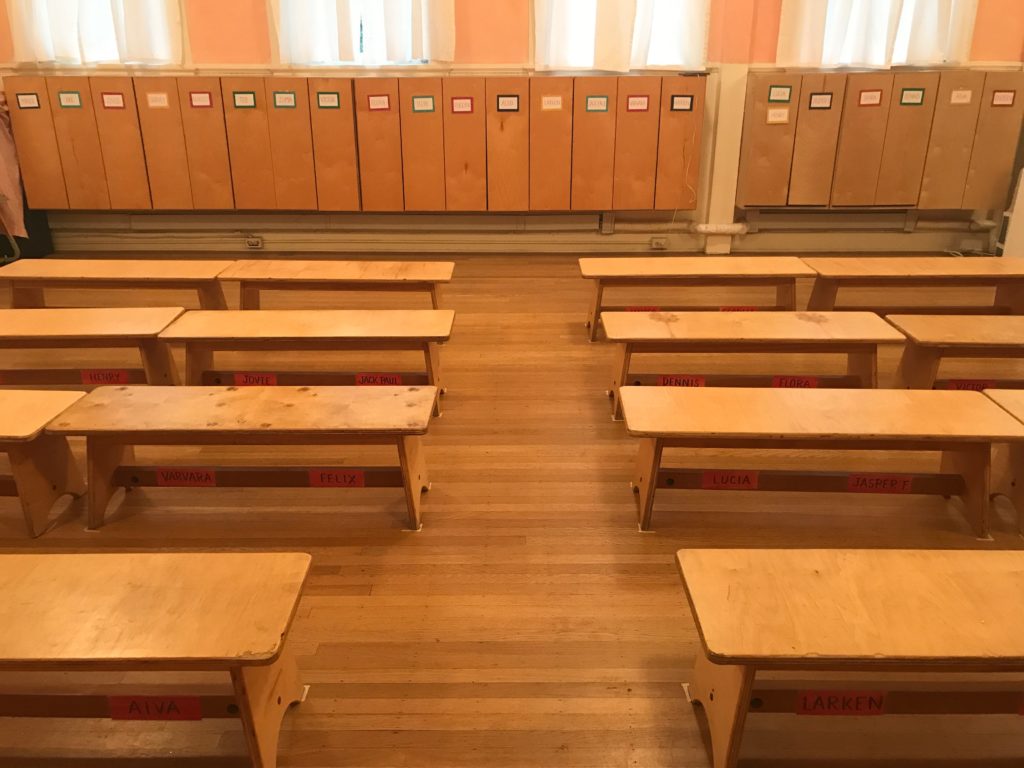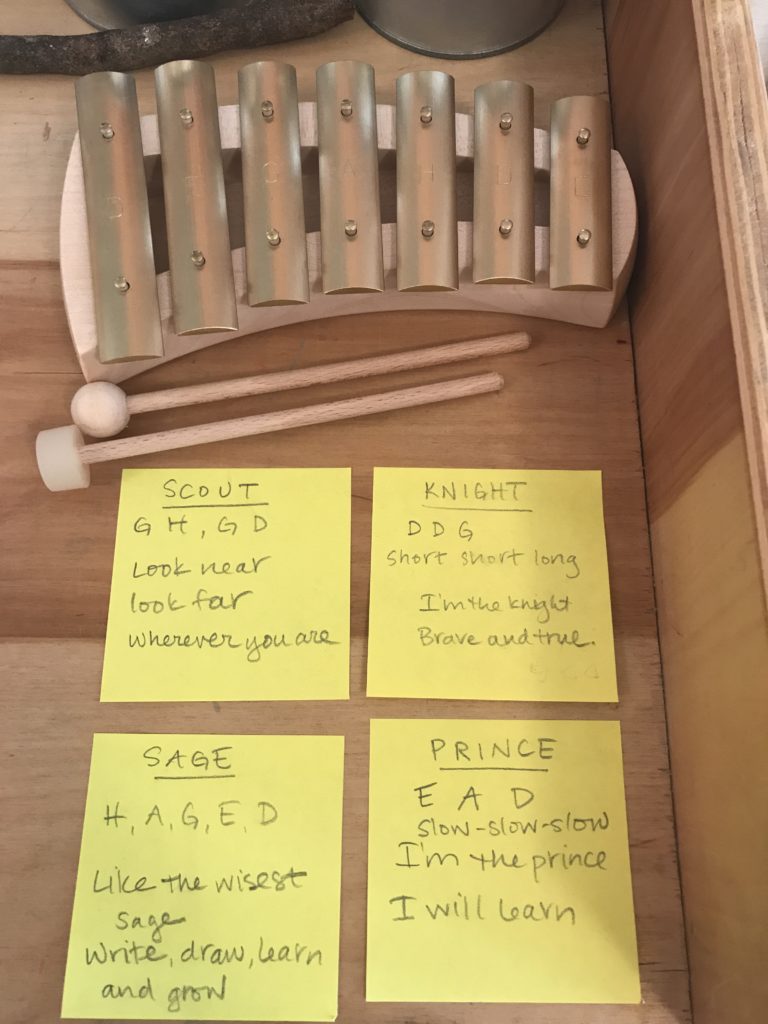
Our school started using the movable classroom about six years ago. Back in 2011, the first and second grade classrooms were outfitted with benches and cushions, instead of the traditional desks. Those pioneering teachers shared innovative ideas about how to have more movement and activity in their classrooms. Those children are now in 7th and 8th grade and I observe them to be able-bodied and capable of connecting with their teachers and peers.
Over the years, teachers at our school are of mixed opinions about working with the movable classroom arrangement of benches and cushions. While some appreciate the flexibility and movement opportunity, others prefer traditional chairs and benches. I am thankful that our school gives the teacher freedom to choose the arrangement that works best, based on his or her teaching style and observation of students.
In the past few years it has worked out that the first grade starts out with the movable classroom and at some point, sometimes after Thanksgiving, Christmas or the end of the school year, they switch to desks. Fortunately, our school has the flexibility of owning a set of benches and a set of desks for the first grade.
As I was preparing to teach first grade for the first time, I really did not have a clear picture of the benefits and drawbacks of the movable classroom. It was difficult for me to envision how we would work with them, so I’m glad I had a couple of enthusiastic colleagues who have shared their experience and expertise. We’ve now had six days of school and I couldn’t imagine doing it any other way.
So far, I already have a few observations.
- In contrast to desks, the movable classroom is less convenient for bookwork. Students don’t have any of their supplies at their places, so systems for passing out supplies are required. This takes time and energy to create. (At my school, the alternative is lightweight tables, which don’t have storage, so a system for passing out supplies is necessary regardless.)
- The movable classroom definitely encourages movement. Even after just three days, my first graders are so adept at moving their benches, we’ve moved them back and forth 2-3 times during a lesson and I find myself looking for ways to incorporate activity into everything we do, knowing that it would take just a couple of minutes to have a nice big open space for movement.
- I love that the movable classroom is helping me to be more observant of my students’ posture. Every time we sit with our cushions, I scan the room to make sure we’re avoiding the W sit (with the legs turned back.) Also, because the students never sit in a chair with a back, they are developing core strength throughout our lessons. If I see a student lay down or flop around a bit, I know that he or she is getting tired and core strength is building.
- The movable classroom requires lots of guidance, direction and management from the teacher. Safety is a huge consideration and there are options that I won’t consider until I have complete faith and confidence in my students’ behavior. For example, even though my students are doing really well with standing on benches and jumping off without toppling, we haven’t yet turned the benches upside down for balance beam work. We’ll carefully work up to it, so I know we can be safe.
This final point is worth some extra consideration. If you do a Google search for “movable classroom” you’re likely to find all kinds of creative, innovative and somewhat precarious arrangements of benches and cushions. In my research I’ve seen benches stacked three-high and cushions piled up as landing nests. I love that the benches and cushions can allow for this creativity, but I worry that teachers in movable classrooms feel pressured to create these innovative arrangements right away, before they know their students can be safe with this activity.
I feel strongly that students should not walk a raised balance beam or climb a stack of benches without a spotter who has a strong sense of responsibility. My first graders are doing pretty well, but I’m still in the process of building that sense of responsibility. I’m excited that my students will gain that trust in one another, but I also recognize that it will take time to build.
I hope to keep you posted as that trust develops, but for now I thought I’d share the beginnings of our work with the movable classroom.
As I was preparing this summer, I realized there were so many different ways my students could interact with their benches and cushions. I also recognized that my students would be able to hold the appropriate postures if they had an image, glockenspiel melody and verse to connect with. In keeping with the first grade fairy tale theme, this is what I came up with:
- The prince
- The knight
- The sage
- The scout

The Prince
The prince is sitting on the bench, with his hands clasped on the edge. He is eager to learn how to become king, so he leans slightly forward and listens attentively. The melody is G-G-D (short-short-long, repeat). “I’m the prince. I will learn.” This is the position my students are in most frequently during our school day.
The Knight
The knight is standing in front of the bench, with arms crossed over his heart in front, ready to pledge devotion to the task ahead. The melody is D-D-G (short-short-long). “Like a knight. Brave and true.”
The Sage
The sage is sitting on a cushion, with legs criss-cross under the bench, ready to work. Honestly, before the students can move into sage position, there is so much that must happen (passing out cushions, books, crayons, etc.) that the students don’t need much of a reminder to find the right way to position themselves. I simply play a descending tone on the glockenspiel.
The Scout
The scout is standing on top of the bench, with his hand at his eyes. This position, to my mind, requires the most amount of forethought and planning. Standing on the bench safely is absolutely required before any of the other fun movable classroom exercises can be undertaken, so it’s worth investing the time and energy on the scout pose. One of the most important components of our daily morning rhythm includes The Scout position, and I included it so standing on the bench would become an everyday, easy part of the students rhythm. Still, whenever we do it I can sense the students’ excitement, so it’s tempered with a holding melody and rhyme. D-G-D-A (short long, short long) “Look near. Look far.”
I know that as we continue to work we’ll find more ways of working with the benches. In fact, after the students’ subject lessons this week I can see that they’ll need to learn to stand behind their benches, with their cushions tucked underneath.
I can’t emphasize how helpful it is to have these little images, melodies and rhymes. Just yesterday, after I played the tone for the knight, the students surprised me by singing, “I’m the knight. Brave and true,” without any encouraging at all from me.
You can bet that brought a smile to my face. And those first graders were quite pleased with themselves. Such a bunch of charmers, those kids.




Thank you so much for posting your experiences of the movable classroom. I am the first to do this in my school and I am glad to know that others are going through it for the first time as well. We are a few weeks into school and I also find that the children are very good at moving the benches. We did try turning some benches over and walking on the bottom beam in a very slow fashion during a circle activity and it went very smoothly. Every other bench in the circle was turned over so there was some relief between the challenges.
I love getting this little peek into my boy’s day. And I confess I was so pleased when I realized you were going to start the year off with benches. For me as a parent, my concern was how he would react to going from the primarily free play of kindergarten–with plenty of space for moving about freely–to organized sitting in rows of desks. The benches seem like such an easy and gentle transition to that. I’m glad it’s going so well for all of you! (By the way, he was disappointed and wanted desks. Lol! I think he associates them with the “big grades.” But now he loves the responsibility of moving the benches, and I look forward to the excitement that’s sure to come when it’s time to bring in the desks.)